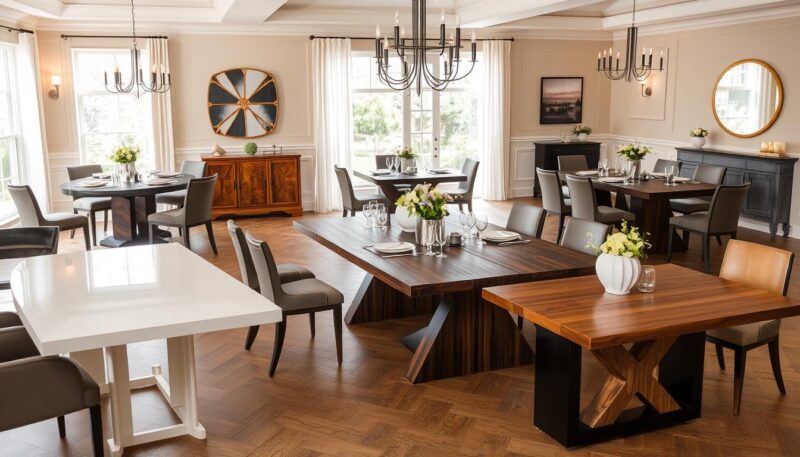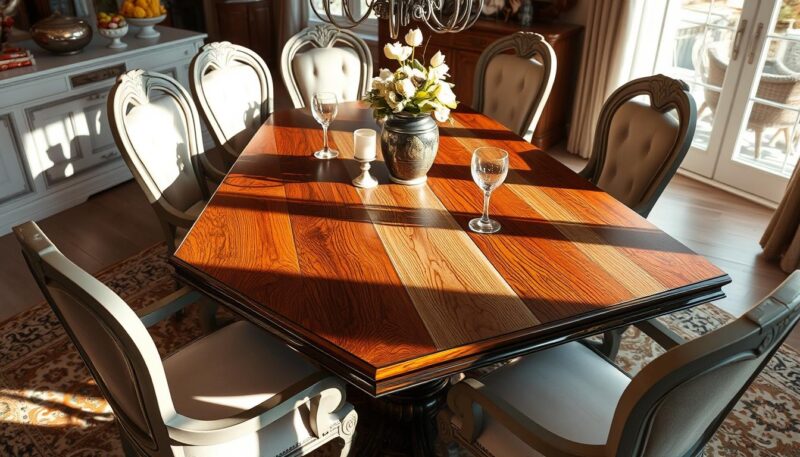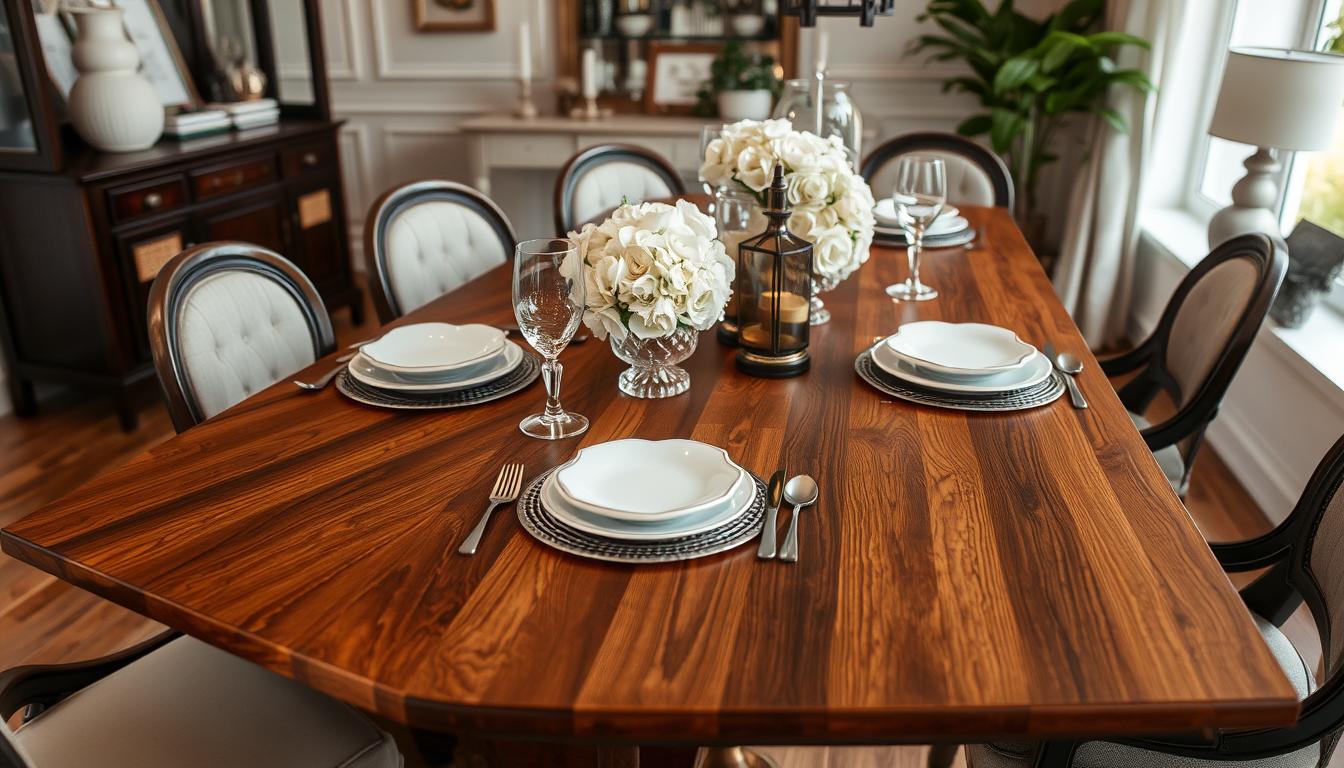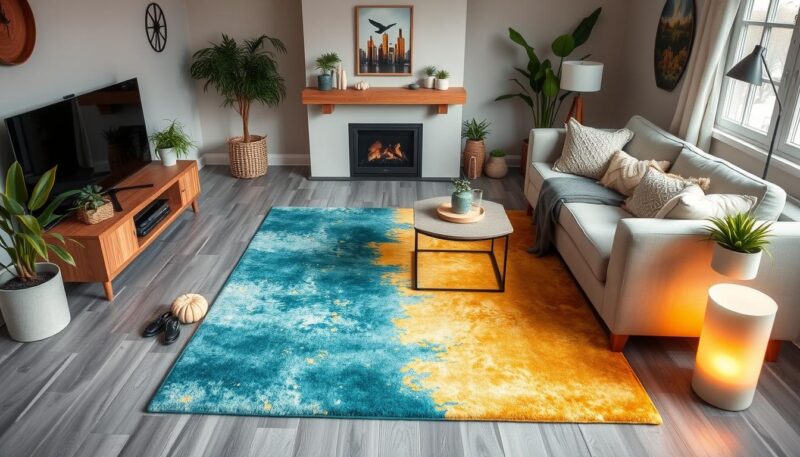Choosing the right finish for your dining room table is crucial to protect the surface and maintain its beauty over time. This article will explore the key options, including waxes, oils, varnishes, and lacquers, to help you determine the best finish for your specific needs and preferences. We’ll compare the durability, application, and maintenance requirements of each type of finish, as well as discuss how to prepare the table surface for a flawless end result.
When it comes to dining room tables, durability is a top priority. After all, these surfaces see a lot of daily use and must withstand everything from spills and scratches to hot dishes and frequent cleaning. Among the recommended finishes, varnishes are often highlighted as the most durable option. The Manns Extra Tough Interior Varnish, for example, is described as a water-based single-component varnish that provides exceptional protection, while the Fiddes Clear Glaze is a solvent-based, high-build polyurethane varnish known for its long-lasting sheen.
As an alternative to varnishes, hard wax oils are also worth considering. Brands like Fiddes and Osmo offer durable hard wax oil options, such as Fiddes Hard Wax Oil Natural and Osmo Polyx Oil Raw (3044), that can provide a beautiful, natural-looking finish while still offering impressive protection against daily wear and tear. Manufacturers recommend applying a maximum of two coats of hard wax oil on bare wood table tops to prevent wax build-up that could easily be marked or scratched.
For stripped pine table tops, hard wax oils like Manns Premier Top Oil and Osmo Top Oil are often recommended for their ability to enhance the wood’s color and grain while delivering long-lasting durability. When staining a table top, varnished or oiled finishes can be applied post-staining, allowing you to customize the final look based on your desired outcome.
Worktop oils, such as Manns Premier Top Oil and Osmo Top Oil, are also deemed suitable for dining room table tops due to their resistance to spills and stains. If you’re looking to achieve a durable black finish, you can explore options like black wood stains and tinted oils, or opt for black varnishes or paints.
The decision on the best finish for your dining room table often comes down to prioritizing either durability or ease of maintenance. Varnishes are generally considered more durable, while wood oils are typically easier to maintain and restore without the need for stripping the old finish.
Key Takeaways
- Varnishes are the most durable option for dining room table finishes.
- Hard wax oils provide a natural-looking finish with good protection against daily wear and tear.
- Worktop oils offer resistance to spills and stains, making them a suitable choice for table tops.
- Achieving a durable black finish can be done with black wood stains, tinted oils, or black varnishes/paints.
- The choice between varnishes and wood oils often comes down to prioritizing durability or ease of maintenance.
Understanding the Different Types of Wood Finishes
Navigating the world of wood finishes can be a nuanced endeavor, with a wide array of products, each boasting unique properties and characteristics. Two popular natural finishes that deserve attention are waxes and oils, both of which offer distinct advantages for your dining room table.
Waxes and Oils
Waxes, such as the esteemed carnauba and beeswax, provide a low-sheen, satin-like finish that effortlessly enhances the natural beauty of your wood. These finishes penetrate deep into the grain, offering a degree of protection while maintaining a warm, inviting aesthetic. The application process is often straightforward, and the results are easy to maintain, though they may require more frequent reapplication over time.
Oils, on the other hand, also soak into the wood, creating a captivating natural look that can be more durable than waxes. Tung and linseed oil are two prime examples that impart a rich, mellow hue while shielding the surface from wear and tear. The curing process for oil finishes, however, can be a bit more time-consuming compared to their wax counterparts.
| Finish Type | Appearance | Durability | Application | Maintenance |
|---|---|---|---|---|
| Wax | Low-sheen, satin-like | Moderate | Easy | Frequent reapplication |
| Oil | Warm, natural look | Higher | Moderate | Less frequent |
“Pigmented wood primer like Target Coating’s EMTECH® HSF5000PSFS is ideal for open-grained wood and engineered veneers, providing excellent hiding power.”
The Importance of Durability for Dining Room Tables
When it comes to selecting the perfect finish for your dining room table, durability should be a top priority. After all, these surfaces see a significant amount of daily use and abuse – from serving meals to hosting craft projects and more. Choosing a finish that can withstand the demands of a busy household is crucial to maintaining your table’s appearance and structural integrity over time.
Highly durable finishes, such as polyurethane varnishes and catalyzed lacquers, can provide a tough, scratch-resistant barrier that protects against everyday wear and tear. These finishes are favored by professionals for their exceptional resilience against moisture, stains, and chemicals. However, they may require a more involved application and maintenance process compared to simpler options like oils and waxes.
Oil-based polyurethane, for instance, offers a warm amber tone that enhances the natural beauty of wood grains, while water-based polyurethane dries faster and emits minimal odor. Wax finishes, on the other hand, provide a subtle sheen but are less popular for long-term protection due to the need for multiple applications.
Regardless of the finish you choose, it’s essential to maintain the integrity of your dining room table over time. This includes regularly monitoring humidity levels (between 40%-45% year-round) to prevent cracking or swelling, and using felt pads to protect against scratches from items placed on the surface. Consistent dusting with a clean microfiber cloth can also help prevent micro-scratches, while applying ultraviolet protectant finishes can safeguard against sun damage.
“Choosing a durable finish for your dining room table is crucial for maintaining its appearance and structural integrity over time. Highly resilient options like polyurethane and lacquer can provide exceptional protection, though they may require more involved application and maintenance.” – Bob Flexner, wood finishing expert and author
By investing in a durable finish and implementing proper care and maintenance, you can ensure your dining room table remains a cherished centerpiece of your home for years to come.

Applying and Maintaining Different Finishes
Ease of Application and Cleanup
When it comes to applying and maintaining wood finishes for your dining room table, the ease of application and cleanup can make a significant difference. Oil finishes, for instance, are known for their natural, matte appearance and simple application process. However, they may not be as durable against stains and spills compared to other options.
Varnish, on the other hand, provides excellent protection against moisture, stains, and scratches, forming a durable, clear layer on the wood surface. The choice of sheen level can also be tailored to your preferences. Lacquer, a fast-drying finish, offers a polished look in high-gloss or satin finishes, but can be prone to chipping and may require periodic refinishing.
Polyurethane, available in both oil-based and water-based formulations, offers strong protection against wear and tear. Water-based polyurethane has the advantage of less odor compared to oil-based options. Shellac, a traditional finish, provides a warm, amber tone and glossy sheen, but requires more frequent maintenance.
When considering the ease of application and cleanup, water-based finishes like polyurethane and lacquer tend to be more user-friendly, offering simpler cleanup with just soap and water. Solvent-based finishes, such as oil-based polyurethane and lacquer, may require more specialized cleaning products and techniques.
Ultimately, the choice of finish should be based on your personal preferences, the desired aesthetic, and the level of maintenance you’re willing to commit to. Understanding the unique characteristics of each finish can help you make an informed decision that will keep your dining room table looking its best for years to come.
What is the Best Finish to Put on a Dining Room Table?
When it comes to selecting the best finish for your dining room table, there is no one-size-fits-all solution. The ideal choice will depend on a variety of factors, including the table’s wood type, your desired aesthetic, and the level of durability required. By understanding the unique properties and considerations of different finish options, you can make an informed decision that strikes the perfect balance between functionality and appearance.
Highly durable finishes like polyurethane varnishes and catalyzed lacquers can provide excellent protection against scratches, stains, and moisture, ensuring your dining table remains in pristine condition for years to come. However, these more robust finishes may come at the expense of the wood’s natural beauty, potentially dulling or obscuring its unique grain and character.
On the other hand, softer finishes like oils and waxes can enhance the wood’s natural look and feel, giving it a warm, inviting appearance. These options, however, may require more frequent maintenance and may not offer the same level of protection as their tougher counterparts.
When comparing finish options, it’s essential to consider the specific characteristics of the wood you’re working with. Certain finishes may be better suited to different wood types, such as oak, maple, cherry, or mahogany. Factors like the wood’s porosity, grain, and overall appearance can all play a role in determining the most suitable finish.
Ultimately, the “best” finish for your dining room table is the one that strikes the perfect balance between your desired aesthetic, the table’s durability requirements, and the unique properties of the wood itself. By carefully weighing these considerations, you can ensure that your dining table not only looks stunning but also stands the test of time.
Preparing the Table Surface for Finishing
Preparing the surface of your dining room table is a crucial step before applying a new finish. This process involves carefully removing any existing finishes, such as waxes, oils, or varnishes, and then sanding the surface to ensure a smooth, even foundation for the new finish. By taking the time to properly prepare the table, you can help guarantee that the final finish adheres properly and provides the desired level of protection and aesthetic appeal.
Stripping and Sanding Techniques
Begin by stripping away any old finishes using a chemical stripper or sanding. This meticulous task is necessary to create a clean slate for the new finish. Once the existing finish has been removed, sand the table top using 80 or 120 grit sandpaper to smooth out the surface. Then, progress to a medium to fine paper, such as 120, 160, 180, or 240 grit, to get rid of any light scratches or imperfections left behind by the coarser sandpaper.
- Start with 80 or 120 grit sandpaper to remove the existing finish.
- Move to 120, 160, 180, or 240 grit sandpaper to smooth the surface.
- Ensure a clean, even surface by sanding in the direction of the wood grain.
After sanding, you may want to apply a wood conditioner, especially if you’re working with a softer wood like pine or fir. This helps prevent blotchiness and ensures the stain or finish is absorbed evenly. Be sure to follow the manufacturer’s instructions for the best results.
By taking the time to carefully prepare the table surface, you’ll be setting the stage for a beautiful, long-lasting finish that will protect your dining room table for years to come.
Factors to Consider When Choosing a Table Finish
When it comes to selecting the best finish for your dining room table, there are several important factors to consider. Balancing aesthetics and functionality is crucial, as the finish you choose will not only impact the overall visual appeal of your table but also its durability and longevity.
One key aspect to understand is the unique properties of different finish types. Oil finishes, for instance, provide a natural, matte appearance and require regular maintenance to keep the wood protected and looking its best. Varnishes, on the other hand, create a hard, protective coating that ranges from matte to glossy, offering excellent resistance to moisture, stains, and scratches.
Lacquer finishes deliver a high-gloss, glass-like appearance, but they may be more prone to chipping and require professional application. Polyurethane, both oil-based and water-based, offers varying levels of sheen and is highly resistant to water, stains, and wear and tear, making it a popular choice for dining tables that see heavy use.
- Oil finishes: Natural, matte appearance, require regular maintenance
- Varnishes: Hard, protective coating, ranging from matte to glossy
- Lacquer: High-gloss, glass-like appearance, potential for chipping
- Polyurethane: Highly resistant to water, stains, and wear, varying sheen levels
When choosing a finish, it’s essential to consider the intended use of your dining table. If it’s a table that will see frequent use, a more durable option like polyurethane may be the best choice. However, if the table is primarily for decorative purposes, a more delicate finish like shellac or a stain-and-topcoat combination may be more suitable.
Ultimately, the decision comes down to balancing the aesthetic you desire with the practical needs of your dining table. By understanding the properties of different finishes and how they’ll interact with your table’s usage, you can make an informed choice that ensures your table looks beautiful and stands the test of time.

“When it comes to choosing a table finish, it’s all about finding the perfect balance between form and function. The right finish can transform a dining table from a mere utilitarian piece to a true work of art.”
Conclusion
Selecting the right finish for your dining room table is a crucial decision that can have a lasting impact on its appearance and longevity. By understanding the diverse range of wood finishes, their unique properties, and the key factors to consider, you can confidently choose the best solution to protect and enhance your table’s natural beauty for years to come.
Whether you opt for a durable polyurethane varnish, a natural oil or wax, or a combination of finishes, the key is to select a finish that aligns with your specific needs, preferences, and the intended use of the table. By carefully weighing factors such as durability, ease of application, environmental impact, and the overall aesthetic you desire, you can ensure your dining room table is not only visually stunning but also well-equipped to withstand the demands of everyday use.
Ultimately, the summary of key considerations and choosing the best finish for your dining room table is a personalized process that requires thoughtful evaluation. By applying the insights and recommendations discussed throughout this article, you can make an informed decision that will safeguard your investment and create a lasting impression in your dining space.
Source Links
- https://www.wood-finishes-direct.com/faq/table-finishes
- https://www.bobvila.com/articles/best-finish-for-kitchen-table/
- https://www.benjaminmoore.com/en-us/interior-exterior-paints-stains/how-to-advice/painting-101/choosing-paint-finish
- https://www.targetcoatings.com/2023/09/20/types-of-wood-finishes/
- https://www.modernloftinteriors.com/blogs/creative-loft-blog/extending-the-lifespan-of-your-dining-table?srsltid=AfmBOor-5ba2QuIKzfyLencbWXg6K3ThUBTAa75_z7zcmuX7iYGkqaar
- https://www.modernloftinteriors.com/blogs/creative-loft-blog/extending-the-lifespan-of-your-dining-table?srsltid=AfmBOoqKxq8Zz6X5dXKI3eGQjj6wM0_HaG8tTGkLZSwcTWBYntjifunt
- https://blog.lostartpress.com/2023/11/12/a-finish-for-the-top-of-a-dining-table/
- https://sawmillcreek.org/showthread.php?37309-Tough-Finish-for-Dining-Table
- https://www.2modern.com/blogs/modern-how-to/best-finish-for-a-dining-room-table?srsltid=AfmBOooqNKXqC2mvYHk35FGzwzzjfBMUZvCzxrQYwB6PYDtxtwWLLxXn
- https://woodweb.com/knowledge_base/Tough_Finishes_for_Table_Tops.html
- https://littlereesorhouse.com/blog/how-to-refinish-a-wooden-dining-table
- https://sawmillcreek.org/showthread.php?73929-Best-finish-for-dining-room-table
- https://www.thisoldhouse.com/furniture/21195125/how-to-refinish-a-dining-table
- https://www.2modern.com/blogs/modern-how-to/best-finish-for-a-dining-room-table?srsltid=AfmBOoqfyj8VWQxrqg40PuEDEr1gRq8ZLgLMrnpaQc8Qb0VdVdKiMndg
- https://www.grainandframe.com/how-to/resurfacing-table-tops/
- https://www.thisoldhouse.com/21016025/how-to-finish-a-wood-table
- https://www.blacktailstudio.com/blog/how-to-finish-a-table
- https://www.2modern.com/blogs/modern-how-to/best-finish-for-a-dining-room-table?srsltid=AfmBOorL6ANZjLLtusfgvpcaQxQejcGdIJCkTOI5NtiM5cOYfg5uviJR
- https://www.addicted2decorating.com/new-dining-table-finish-options.html
- https://n3nano.com/blogs/n3-nano-finishing-blog/best-finish-for-wood-kitchen-tables-durability-and-style?srsltid=AfmBOorh8i4PASeIoJ60jEooeSEcFhsw2AjCWM6ReXkuSVmbpWujooJD
- https://www.modernloftinteriors.com/blogs/creative-loft-blog/extending-the-lifespan-of-your-dining-table?srsltid=AfmBOoq_6eD2Wn8TEmCaxBJdNn7T1Q0uAJWTbdkquFjovs29dy8yWiw1
- https://www.paramountstone.co.uk/what-is-the-best-material-for-a-dining-table/


